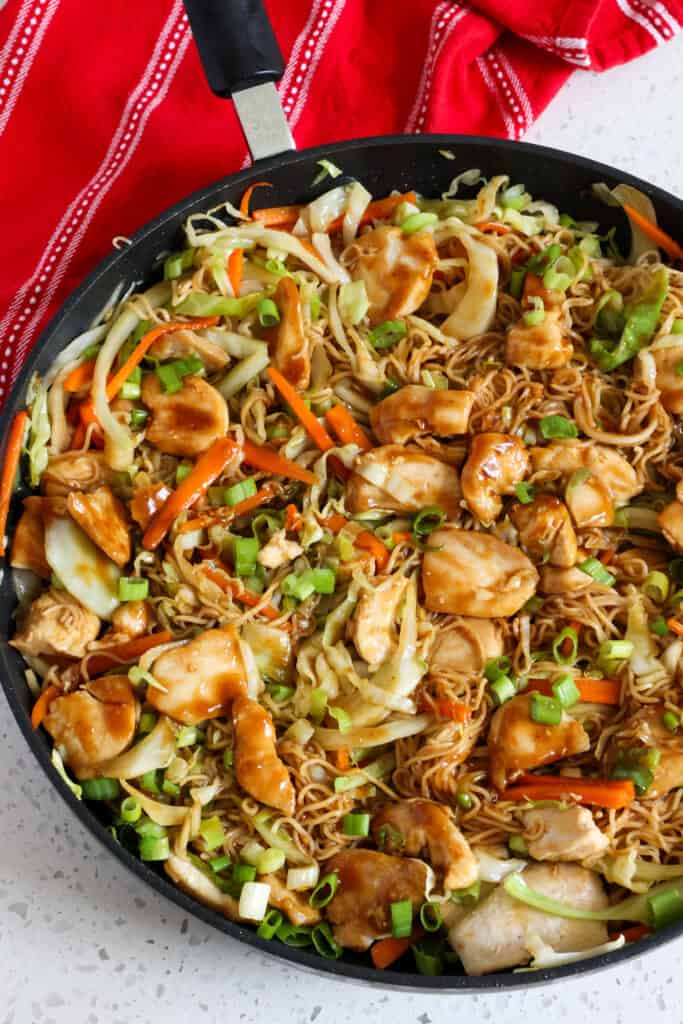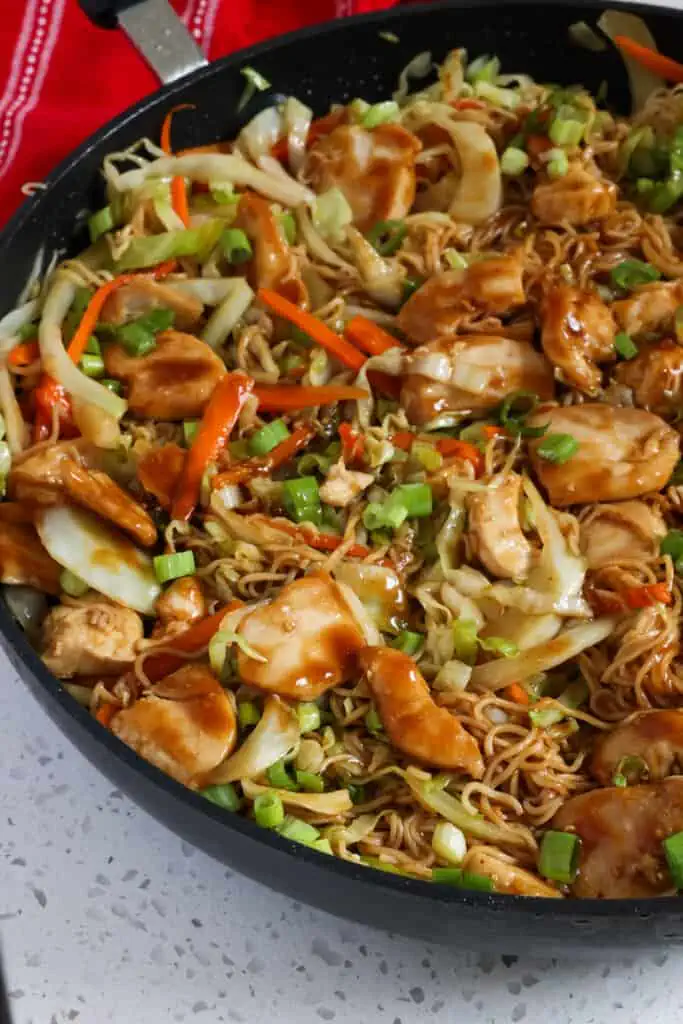Preparation
First, chop all your vegetables, leaving the cabbage for last. Cover everything with lightly dampened paper towels while you work. Meanwhile, cook your Chinese noodles according to the package instructions in a large pot of boiling water and drain well. The ones I purchase take about 3 minutes, and I am usually right on top of that, so they do not overcook as you want them, just a little bit firm. Drain the noodles in a colander. Add about 1 teaspoon of sesame oil and toss well to coat. Set the noodles aside for just a few minutes.
Now, cut your chicken into small bite-sized slices. Then mix your soy sauce, hoisin sauce, ginger, mirin, Chinese cooking wine, sesame oil, and cornstarch in a small bowl. Double the sauce ingredients if you like a lot of sauce like my family.
Cooking
Things really start moving, so the noodles need your undivided attention. Heat a nonstick skillet or wok over medium heat until a drop of water added to the skillet sizzles. Add the noodles that you set aside. Work in two batches, spreading the noodles out in the pan. Leave undisturbed for 1-2 minutes or until they start to get crispy. Now flip the noodles over and let the other side get crispy. Set the cooked noodles aside and add about 1 tablespoon of vegetable oil.
Turn the heat up to medium-high, and once the oil is almost smoking, add the chicken. Cook until golden brown on both sides and cooked through. Work in batches, so you don’t crowd the skillet. Remove the chicken to a plate. Now add a bit of vegetable oil to the skillet over medium-high heat. Once it is good and hot, add the cabbage and carrots. Cook until the vegetables are crisp-tender, usually about 2-3 minutes. Turn the heat to medium-low and add the garlic and the green onions. Cook for about 30-60 seconds, stirring constantly, as there will be a lot of residual heat in the pan.
Finally, turn the heat to medium, adding the chicken and noodles back to the pan to warm. Add the sauce and stir to combine, cooking for 2 minutes or until the sauce is thickened and everything is coated with sauce. Serve as soon as possible while everything is at its best.

Recipe Tips
- Chinese noodles can be found in the Asian food section of your grocery store. Other noodles that work well are ramen, Yakisoba, and even thin spaghetti noodles.
- For optimal taste and texture, do not overboil the noodles, as you want them to have a little firmness.
- Chop your veggies relatively small and shred your cabbage thin to ensure a quicker cooking time.
- Do not cube your chicken. Instead, cut it into bite-size slices that are longer and thinner. This will help cook it all the way through without drying it out.
- Oyster sauce is traditionally used in chow mein sauce, but not everyone can access it. Hoisin sauce is a tasty, albeit different, substitute.
- When cooking the chicken and vegetables, use medium-high to high heat and an oil with a high smoking point, like vegetable, canola, or peanut oil.
- Other vegetables to add are bok choy, bean sprouts, mushrooms, broccoli, snow peas, and bell peppers.
- Other proteins that work well with this recipe are beef, pork, and shrimp.
- Double the sauce ingredients if you like a lot of sauce like my family does.
- Plan on serving this as soon as possible so the vegetables are still crisp-tender.

Difference Between Chow Mein and Lo Mein?
Honestly, the difference is just in how the noodles are prepared. With chow mein, the noodles are boiled al dente (a little firm when bitten), drained well, coated with oil, and pan-fried to give them a little crispiness. Lo mein noodles are boiled soft and added at the completion of the dish. Usually, for chow mein, a thinner noodle that resembles a ramen noodle, which is thin and curly, is used. I used dried Chinese noodles. For lo mein, usually, thicker straight noodles are prepared.
Storage
Store leftovers in an airtight container in the fridge for up to 3 days. Reheat in the microwave at reduced power or in a skillet on the stovetop over low heat.
To freeze, first cool to room temperature. Then, place the chow mein in a freezer-safe container and freeze for up to 3 months. Thaw in the fridge overnight. Reheat on the stovetop over low heat or in the microwave at reduced power.
Easy Chicken Chow Mein Recipe
A delectable classic Chinese dish filled with chicken, carrots, cabbage, celery, onions, and crispy stir-fried noodles. Make this easy Chicken Chow Mein at home, and it will easily replace your favorite takeout!
Course: main meal chicken
Cuisine: Chinese
Prep Time: 15minutes
Cook Time: 20minutes
Servings: 4 servings
Calories: 619kcal
Ingredients
- Chow Mein Sauce
- ¼ cup low-sodium soy sauce
- 1 ½ tablespoon hoisin sauce or oyster sauce
- 1 tablespoon grated ginger or ginger paste
- 1 tablespoon mirin or granulated sugar
- 1 tablespoon Chinese cooking wine optional
- 2 teaspoons sesame oil
- 2 teaspoons cornstarch
- Chow Mein
- 8 ounces chow mein noodles see notes
- ½ teaspoon sesame oil
- 2-3 tablespoons vegetable oil or peanut oil
- 1 ½ lbs boneless skinless chicken breasts or chicken thighs cut into thin bite-size pieces
- 4 cups green cabbage finely shredded
- 2 carrots julienned
- 3 cloves garlic minced
- 4 green onions
Instructions
- Boil Chinese noodles according to package instructions. Drain well and toss with sesame oil.
- Whisk the soy sauce, hoisin sauce, ginger, mirin, Chinese cooking wine, sesame oil, and cornstarch in a small bowl.
- Heat a large skillet over medium heat until a drop of water added sizzles. Working in 2 batches, add the noodles and cook undisturbed for 1-2 minutes or until they get crispy. Flip and crisp the other side. Repeat with the second batch of noodles. Remove to a bowl.
- Add 1 tablespoon of vegetable oil to the same skillet over medium-high heat. Working in batches, cook the chicken until golden brown on both sides and cooked through. Remove the chicken to a plate.
- Add 1 tablespoon vegetable oil to the same skillet over medium-high heat until almost smoking. Add the cabbage and carrots. Cook until the vegetables are crisp-tender, which is about 2-3 minutes. Turn the heat to medium-low and add the garlic and the green onions. Cook for about 30-60 seconds, stirring constantly, as there will be a lot of residual heat in the pan.
- Turn the heat up to medium, adding the chicken and noodles back to the pan to warm. Whisk the sauce that you set aside. Add it to the skillet and stir to combine. Cook for 2 minutes or until the sauce is thickened and everything is coated with sauce.
- Serve as soon as possible while everything is at its best.
Delicious and easy Chicken Chow Mein with crispy noodles, golden browned chicken breasts, cabbage, carrots, onions and celery is sure to become of your family’s favorite feasts!
Notes
- Mirin is sweetened sake and is available at some high-end grocery stores. You can substitute 1 tablespoon of sherry with 1/2 tablespoon of brown sugar for mirin. If you can not find the mirin and you do not want to purchase the sherry add 1/2 -1 tablespoon of brown sugar to sweeten the sauce.
- Chinese noodles can be found in the Asian food section of your grocery store. Other noodles that work well are ramen, Yakisoba, and even thin spaghetti noodles.
- Do not overboil the noodles, as you want them to have a little bit of firmness to them.
- Chop your veggies fairly small and shred your cabbage thin to ensure a quicker cooking time.
- Do not cube your chicken. Instead, cut it into bite-size slices that are longer and thinner. This will help cook it all the way through without drying it out.
- Oyster sauce is traditionally used in chow mein sauce, but not everyone has access to it. Hoisin sauce is a tasty, albeit different, substitute.
- When cooking the chicken and vegetables, use medium-high to high heat and an oil with a high smoking point, like vegetable, canola, or peanut oil.
- Other vegetables to consider adding are bok choy, mushrooms, broccoli, snow peas, or bell peppers.
- Other proteins that work well with this recipe are beef, pork, and shrimp.
- If you like a lot of sauce like my family does, double the sauce ingredients.
- Plan on serving this as soon as possible so the vegetables are still crisp-tender.
- Store leftovers in an airtight container in the fridge for up to 3 days. Reheat in the microwave at reduced power.
Nutrition
Calories: 619kcal | Carbohydrates: 54g | Protein: 45g | Fat: 24g | Saturated Fat: 3g | Polyunsaturated Fat: 12g | Monounsaturated Fat: 7g | Trans Fat: 0.1g | Cholesterol: 109mg | Sodium: 1386mg | Potassium: 1020mg | Fiber: 5g | Sugar: 9g | Vitamin A: 5335IU | Vitamin C: 32mg | Calcium: 78mg | Iron: 4mg

